Impact of Land Use Change on Water-Related Ecosystem Services under Multiple Ecological Restoration Scenarios in the Ganjiang River Basin, China
Abstract
:1. Introduction
2. Materials and Methods
2.1. Study Area
2.2. Data Sources
2.3. Ecosystem Services Assessment
2.3.1. Water Yield
2.3.2. Soil Retention
2.3.3. Water Purification
2.3.4. Food Production
2.4. Trade-Off Analysis
2.5. Scenario Design
3. Results
3.1. Land Use Change from 2000 to 2020
3.2. Changes in WESs from 2000 to 2020
3.3. Impacts of Land Use Change on WESs
3.4. Trade-Offs and Synergies between WESs
3.5. Changes in WESs under Multiple Ecological Restoration Scenarios
4. Discussion
4.1. Changes in Land Use Change and WESs
4.2. Impact of Ecological Restoration on WESs
4.3. Implications
4.4. Limitations
5. Conclusions
Supplementary Materials
Author Contributions
Funding
Data Availability Statement
Conflicts of Interest
References
- Costanza, R.; d’Arge, R.; de Groot, R.; Farber, S.; Grasso, M.; Hannon, B.; Limburg, K.; Naeem, S.; O’Neill, R.V.; Paruelo, J.; et al. The value of the world’s ecosystem services and natural capital. Nature 1997, 387, 253–260. [Google Scholar] [CrossRef]
- Maestre, F.T.; Le Bagousse-Pinguet, Y.; Delgado-Baquerizo, M.; Eldridge, D.J.; Saiz, H.; Berdugo, M.; Gozalo, B.; Ochoa, V.; Guirado, E.; Garcia-Gomez, M.; et al. Grazing and ecosystem service delivery in global drylands. Science 2022, 378, 915–920. [Google Scholar] [CrossRef] [PubMed]
- Felipe-Lucia, M.R.; Soliveres, S.; Penone, C.; Fischer, M.; Ammer, C.; Boch, S.; Boeddinghaus, R.S.; Bonkowski, M.; Buscot, F.; Fiore-Donno, A.M.; et al. Land-use intensity alters networks between biodiversity, ecosystem functions, and services. Proc. Natl. Acad. Sci. USA 2020, 117, 28140–28149. [Google Scholar] [CrossRef]
- van Vliet, J. Direct and indirect loss of natural area from urban expansion. Nat. Sustain. 2019, 2, 755–763. [Google Scholar] [CrossRef]
- Reid, W.V.; Mooney, H.A.; Cropper, A.; Capistrano, D.; Carpenter, S.R.; Chopra, K.; Dasgupta, P.; Dietz, T.; Duraiappah, A.K.; Hassan, R.; et al. Ecosystems and Human Well-being: Synthesis; Island Press: Washington, DC, USA, 2005. [Google Scholar]
- Qi, W.; Li, H.; Zhang, Q.; Zhang, K. Forest restoration efforts drive changes in land-use/land-cover and water-related ecosystem services in China’s Han River basin. Ecol. Eng. 2019, 126, 64–73. [Google Scholar] [CrossRef]
- Gao, J.; Li, F.; Gao, H.; Zhou, C.; Zhang, X. The impact of land-use change on water-related ecosystem services: A study of the Guishui River Basin, Beijing, China. J. Clean. Prod. 2017, 163, S148–S155. [Google Scholar] [CrossRef]
- Ouyang, Z.; Zheng, H.; Xiao, Y.; Polasky, S.; Liu, J.; Xu, W.; Wang, Q.; Zhang, L.; Xiao, Y.; Rao, E.; et al. Improvements in ecosystem services from investments in natural capital. Science 2016, 352, 1455–1459. [Google Scholar] [CrossRef] [PubMed]
- Rey Benayas, J.M.; Newton, A.C.; Diaz, A.; Bullock, J.M. Enhancement of Biodiversity and Ecosystem Services by Ecological Restoration: A Meta-Analysis. Science 2009, 325, 1121–1124. [Google Scholar] [CrossRef]
- Lei, J.-C.; Wang, S.; Wu, J.; Wang, J.-W.; Xiong, X. Land-use configuration has significant impacts on water-related ecosystem services. Ecol. Eng. 2021, 160, 106133. [Google Scholar] [CrossRef]
- Zhou, M.; Deng, J.; Lin, Y.; Zhang, L.; He, S.; Yang, W. Evaluating combined effects of socio-economic development and ecological conservation policies on sediment retention service in the Qiantang River Basin, China. J. Clean. Prod. 2021, 286, 124961. [Google Scholar] [CrossRef]
- Gou, M.; Li, L.; Ouyang, S.; Wang, N.; La, L.; Liu, C.; Xiao, W. Identifying and analyzing ecosystem service bundles and their socioecological drivers in the Three Gorges Reservoir Area. J. Clean. Prod. 2021, 307, 127208. [Google Scholar] [CrossRef]
- Wang, Y.; Zhang, Z.; Chen, X. Land Use Transitions and the Associated Impacts on Carbon Storage in the Poyang Lake Basin, China. Remote Sens. 2023, 15, 2703. [Google Scholar] [CrossRef]
- Yang, Y. Evolution of habitat quality and association with land-use changes in mountainous areas: A case study of the Taihang Mountains in Hebei Province, China. Ecol. Indic. 2021, 129, 107967. [Google Scholar] [CrossRef]
- Ma, S.; Wang, L.-J.; Jiang, J.; Zhao, Y.-G. Land use/land cover change and soil property variation increased flood risk in the black soil region, China, in the last 40 years. Environ. Impact Assess. Rev. 2024, 104, 107314. [Google Scholar] [CrossRef]
- Lu, F.; Hu, H.; Sun, W.; Zhu, J.; Liu, G.; Zhou, W.; Zhang, Q.; Shi, P.; Liu, X.; Wu, X.; et al. Effects of national ecological restoration projects on carbon sequestration in China from 2001 to 2010. Proc. Natl. Acad. Sci. USA 2018, 115, 4039–4044. [Google Scholar] [CrossRef] [PubMed]
- Bennett, E.M.; Peterson, G.D.; Gordon, L.J. Understanding relationships among multiple ecosystem services. Ecol. Lett. 2009, 12, 1394–1404. [Google Scholar] [CrossRef] [PubMed]
- Liang, J.; Li, S.; Li, X.; Li, X.; Liu, Q.; Meng, Q.; Lin, A.; Li, J. Trade-off analyses and optimization of water-related ecosystem services (WRESs) based on land use change in a typical agricultural watershed, southern China. J. Clean. Prod. 2021, 279, 123851. [Google Scholar] [CrossRef]
- Yang, S.Q.; Zhao, W.W.; Liu, Y.X.; Wang, S.; Wang, J.; Zhai, R.J. Influence of land use change on the ecosystem service trade-offs in the ecological restoration area: Dynamics and scenarios in the Yanhe watershed, China. Sci. Total Environ. 2018, 644, 556–566. [Google Scholar] [CrossRef]
- Peng, J.; Hu, X.; Wang, X.; Meersmans, J.; Liu, Y.; Qiu, S. Simulating the impact of Grain-for-Green Programme on ecosystem services trade-offs in Northwestern Yunnan, China. Ecosyst. Serv. 2019, 39, 100998. [Google Scholar] [CrossRef]
- Divinsky, I.; Becker, N.; Bar, P. Ecosystem service tradeoff between grazing intensity and other services—A case study in Karei-Deshe experimental cattle range in northern Israel. Ecosyst. Serv. 2017, 24, 16–27. [Google Scholar] [CrossRef]
- Raudsepp-Hearne, C.; Peterson, G.D.; Bennett, E.M. Ecosystem service bundles for analyzing tradeoffs in diverse landscapes. Proc. Natl. Acad. Sci. USA 2010, 107, 5242–5247. [Google Scholar] [CrossRef] [PubMed]
- Feng, X.; Fu, B.; Piao, S.; Wang, S.; Ciais, P.; Zeng, Z.; Lü, Y.; Zeng, Y.; Li, Y.; Jiang, X.; et al. Revegetation in China’s Loess Plateau is approaching sustainable water resource limits. Nat. Clim. Chang. 2016, 6, 1019–1022. [Google Scholar] [CrossRef]
- Chen, Y.; Wang, K.; Lin, Y.; Shi, W.; Song, Y.; He, X. Balancing green and grain trade. Nat. Geosci. 2015, 8, 739–741. [Google Scholar] [CrossRef]
- Villa, F.; Bagstad, K.J.; Voigt, B.; Johnson, G.W.; Portela, R.; Honzák, M.; Batker, D. A Methodology for Adaptable and Robust Ecosystem Services Assessment. PLoS ONE 2014, 9, e91001. [Google Scholar] [CrossRef] [PubMed]
- Jiang, Y.; Gao, J.; Wu, S.; Jiao, K. Mediation effect as the component to ecosystem? Establishing the chain effect framework of ecosystem services across typical karst basin in China. Catena 2023, 221, 106761. [Google Scholar] [CrossRef]
- Verma, S.; Verma, M.K.; Prasad, A.D.; Mehta, D.J.; Islam, M.N. Modeling of uncertainty in the estimation of hydrograph components in conjunction with the SUFI-2 optimization algorithm by using multiple objective functions. Model. Earth Syst. Environ. 2024, 10, 61–79. [Google Scholar] [CrossRef]
- Hamel, P.; Chaplin-Kramer, R.; Sim, S.; Mueller, C. A new approach to modeling the sediment retention service (InVEST 3.0): Case study of the Cape Fear catchment, North Carolina, USA. Sci. Total Environ. 2015, 524–525, 166–177. [Google Scholar] [CrossRef] [PubMed]
- Chen, D.; Jiang, P.; Li, M. Assessing potential ecosystem service dynamics driven by urbanization in the Yangtze River Economic Belt, China. J Env. Manag. 2021, 292, 112734. [Google Scholar] [CrossRef]
- Bai, Y.; Ochuodho, T.O.; Yang, J. Impact of land use and climate change on water-related ecosystem services in Kentucky, USA. Ecol. Indic. 2019, 102, 51–64. [Google Scholar] [CrossRef]
- Ma, S.; Wang, L.-J.; Chu, L.; Jiang, J. Determination of ecological restoration patterns based on water security and food security in arid regions. Agric. Water Manag. 2023, 278, 108171. [Google Scholar] [CrossRef]
- Zheng, H.; Wang, L.; Peng, W.; Zhang, C.; Li, C.; Robinson, B.E.; Wu, X.; Kong, L.; Li, R.; Xiao, Y.; et al. Realizing the values of natural capital for inclusive, sustainable development: Informing China’s new ecological development strategy. Proc. Natl. Acad. Sci. USA 2019, 116, 8623–8628. [Google Scholar] [CrossRef] [PubMed]
- Wang, Y.; Zhang, Z.; Chen, X. Spatiotemporal change in ecosystem service value in response to land use change in Guizhou Province, southwest China. Ecol. Indic. 2022, 144, 109514. [Google Scholar] [CrossRef]
- Verma, S.; Verma, M.K.; Prasad, A.D.; Mehta, D.; Azamathulla, H.M.; Muttil, N.; Rathnayake, U. Simulating the Hydrological Processes under Multiple Land Use/Land Cover and Climate Change Scenarios in the Mahanadi Reservoir Complex, Chhattisgarh, India. Water 2023, 15, 3068. [Google Scholar] [CrossRef]
- Sun, X.; Crittenden, J.C.; Li, F.; Lu, Z.M.; Dou, X.L. Urban expansion simulation and the spatio-temporal changes of ecosystem services, a case study in Atlanta Metropolitan area, USA. Sci. Total Environ. 2018, 622, 974–987. [Google Scholar] [CrossRef]
- Ma, S.; Qiao, Y.-P.; Jiang, J.; Wang, L.-J.; Zhang, J.-C. Incorporating the implementation intensity of returning farmland to lakes into policymaking and ecosystem management: A case study of the Jianghuai Ecological Economic Zone, China. J. Clean. Prod. 2021, 306, 127284. [Google Scholar] [CrossRef]
- Wen, T.; Xiong, L.; Jiang, C.; Hu, J.; Liu, Z. Effects of Climate Variability and Human Activities on Suspended Sediment Load in the Ganjiang River Basin, China. J. Hydrol. Eng. 2019, 24, 05019029. [Google Scholar] [CrossRef]
- He, X.; Miao, Z.; Wang, Y.; Yang, L.; Zhang, Z. Response of soil erosion to climate change and vegetation restoration in the Ganjiang River Basin, China. Ecol. Indic. 2024, 158, 111429. [Google Scholar] [CrossRef]
- Liu, X.; Zhang, L.; She, D.; Chen, J.; Xia, J.; Chen, X.; Zhao, T. Postprocessing of hydrometeorological ensemble forecasts based on multisource precipitation in Ganjiang River basin, China. J. Hydrol. 2022, 605, 127323. [Google Scholar] [CrossRef]
- Hu, H.; Jin, D.; Yang, Y.; Zhang, J.; Ma, C.; Qiu, Z. Distinct profile of bacterial community and antibiotic resistance genes on microplastics in Ganjiang River at the watershed level. Environ. Res. 2021, 200, 111363. [Google Scholar] [CrossRef]
- NCP. InVEST 3.13.0 User’s Guide; Stanford University, University of Minnesota, Chinese Academy of Sciences, The Nature Conservancy, World Wildlife Fund, and Stockholm Resilience Centre: Stanford, CA, USA, 2022. [Google Scholar]
- Li, J.; Xie, B.; Gao, C.; Zhou, K.; Liu, C.; Zhao, W.; Xiao, J.; Xie, J. Impacts of natural and human factors on water-related ecosystem services in the Dongting Lake Basin. J. Clean. Prod. 2022, 370, 133400. [Google Scholar] [CrossRef]
- Wang, Y.; Wang, H.; Zhang, J.; Liu, G.; Fang, Z.; Wang, D. Exploring interactions in water-related ecosystem services nexus in Loess Plateau. J. Environ. Manag. 2023, 336, 117550. [Google Scholar] [CrossRef]
- Xia, H.; Yuan, S.; Prishchepov, A.V. Spatial-temporal heterogeneity of ecosystem service interactions and their social-ecological drivers: Implications for spatial planning and management. Resour. Conserv. Recycl. 2023, 189, 106767. [Google Scholar] [CrossRef]
- Wang, Y.; Zhang, Z.; Chen, X. Quantifying Influences of Natural and Anthropogenic Factors on Vegetation Changes Based on Geodetector: A Case Study in the Poyang Lake Basin, China. Remote Sens. 2021, 13, 5081. [Google Scholar] [CrossRef]
- Ning, K.; Chen, J.; Li, Z.; Liu, C.; Nie, X.; Liu, Y.; Wang, L.; Hu, X. Land use change induced by the implementation of ecological restoration Programs increases future terrestrial ecosystem carbon sequestration in red soil hilly region of China. Ecol. Indic. 2021, 133, 108409. [Google Scholar] [CrossRef]
- Shen, X.; Wang, L.; Wu, C.; Lv, T.; Lu, Z.; Luo, W.; Li, G. Local interests or centralized targets? How China’s local government implements the farmland policy of Requisition–Compensation Balance. Land Use Policy 2017, 67, 716–724. [Google Scholar] [CrossRef]
- Chen, W.; Ye, X.; Li, J.; Fan, X.; Liu, Q.; Dong, W. Analyzing requisition–compensation balance of farmland policy in China through telecoupling: A case study in the middle reaches of Yangtze River Urban Agglomerations. Land Use Policy 2019, 83, 134–146. [Google Scholar] [CrossRef]
- Kong, L.; Wu, T.; Xiao, Y.; Xu, W.; Zhang, X.; Daily, G.C.; Ouyang, Z. Natural capital investments in China undermined by reclamation for cropland. Nat. Ecol. Evol. 2023, 7, 1771–1777. [Google Scholar] [CrossRef] [PubMed]
- Chen, H.; Zhang, X.; Abla, M.; Lu, D.; Yan, R.; Ren, Q.; Ren, Z.; Yang, Y.; Zhao, W.; Lin, P.; et al. Effects of vegetation and rainfall types on surface runoff and soil erosion on steep slopes on the Loess Plateau, China. Catena 2018, 170, 141–149. [Google Scholar] [CrossRef]
- Huang, C.; Zhao, D.; Liao, Q.; Xiao, M. Linking landscape dynamics to the relationship between water purification and soil retention. Ecosyst. Serv. 2023, 59, 101498. [Google Scholar] [CrossRef]
- Chen, W.; Yang, L.; Zeng, J.; Yuan, J.; Gu, T.; Liu, Z. Untangling the increasing elevation of cropland in China from 1980 to 2020. Geogr. Sustain. 2023, 4, 281–293. [Google Scholar] [CrossRef]
- Guo, M.; Ma, S.; Wang, L.-J.; Lin, C. Impacts of future climate change and different management scenarios on water-related ecosystem services: A case study in the Jianghuai ecological economic Zone, China. Ecol. Indic. 2021, 127, 107732. [Google Scholar] [CrossRef]
- Sun, X.; Lu, Z.; Li, F.; Crittenden, J.C. Analyzing spatio-temporal changes and trade-offs to support the supply of multiple ecosystem services in Beijing, China. Ecol. Indic. 2018, 94, 117–129. [Google Scholar] [CrossRef]
- Yang, S.; Bai, Y.; Alatalo, J.M.; Wang, H.; Jiang, B.; Liu, G.; Chen, J. Spatio-temporal changes in water-related ecosystem services provision and trade-offs with food production. J. Clean. Prod. 2021, 286, 125316. [Google Scholar] [CrossRef]
- Zheng, H.; Li, Y.F.; Robinson, B.E.; Liu, G.; Ma, D.C.; Wang, F.C.; Lu, F.; Ouyang, Z.Y.; Daily, G.C. Using ecosystem service trade-offs to inform water conservation policies and management practices. Front. Ecol. Environ. 2016, 14, 527–532. [Google Scholar] [CrossRef]

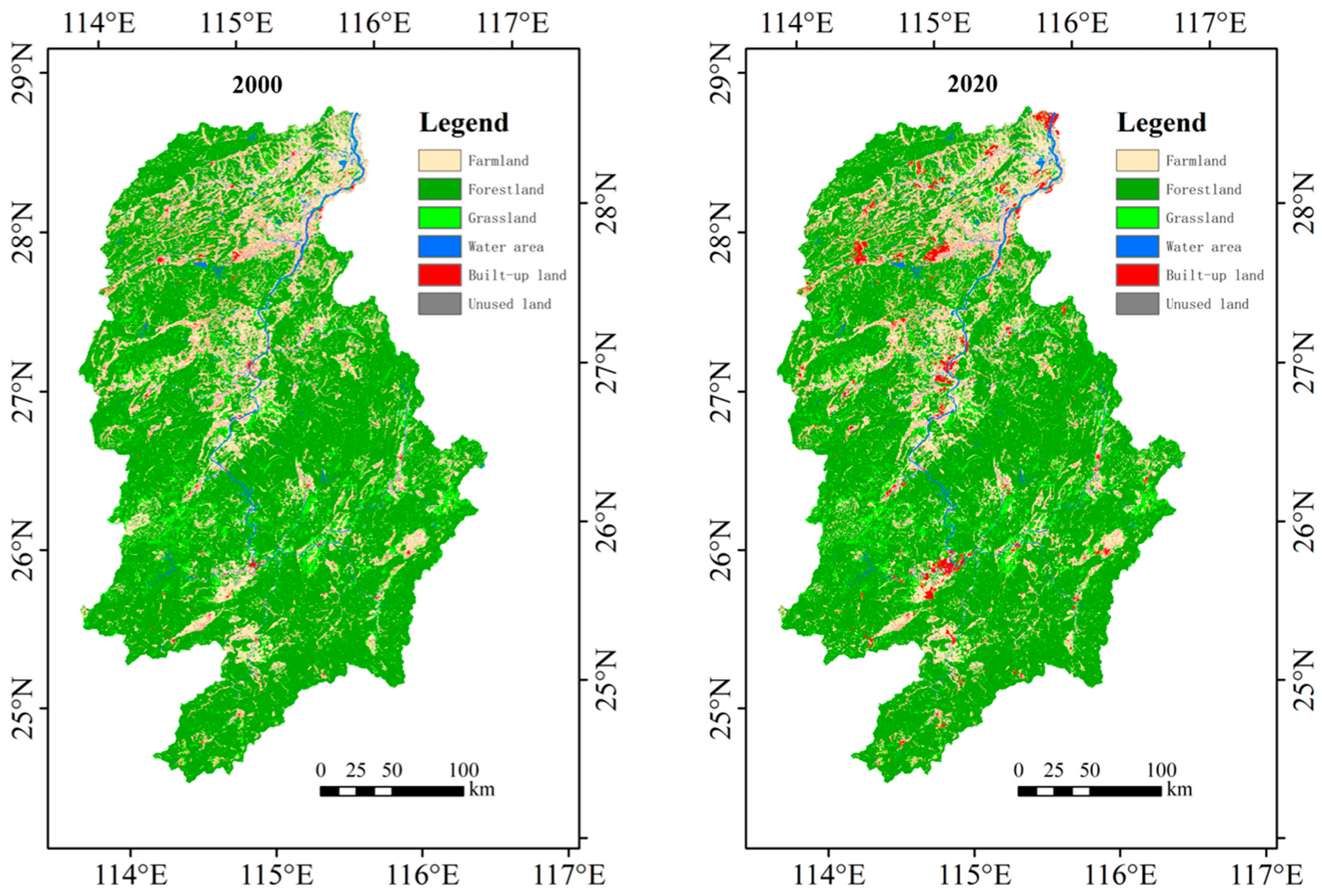
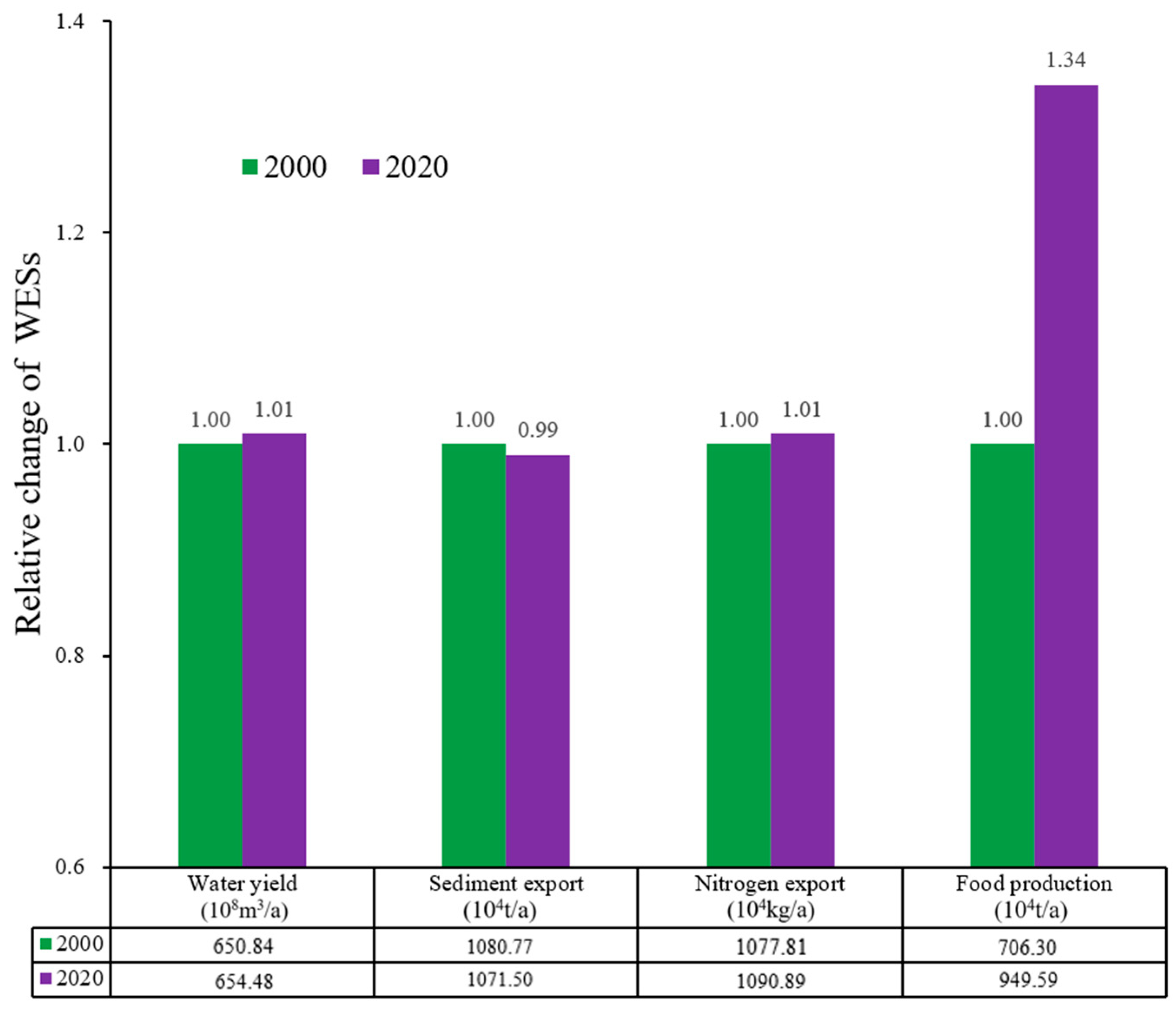
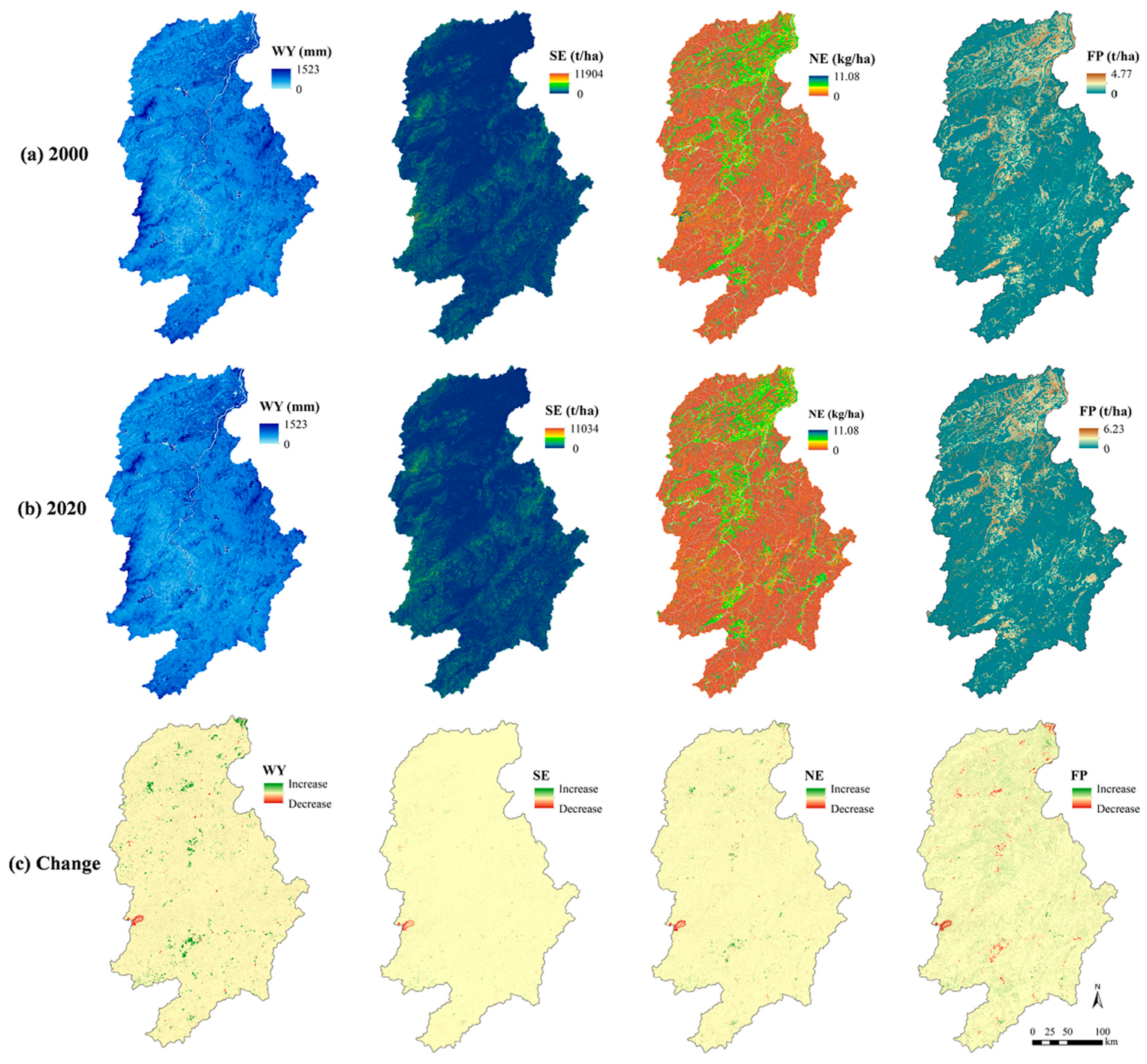
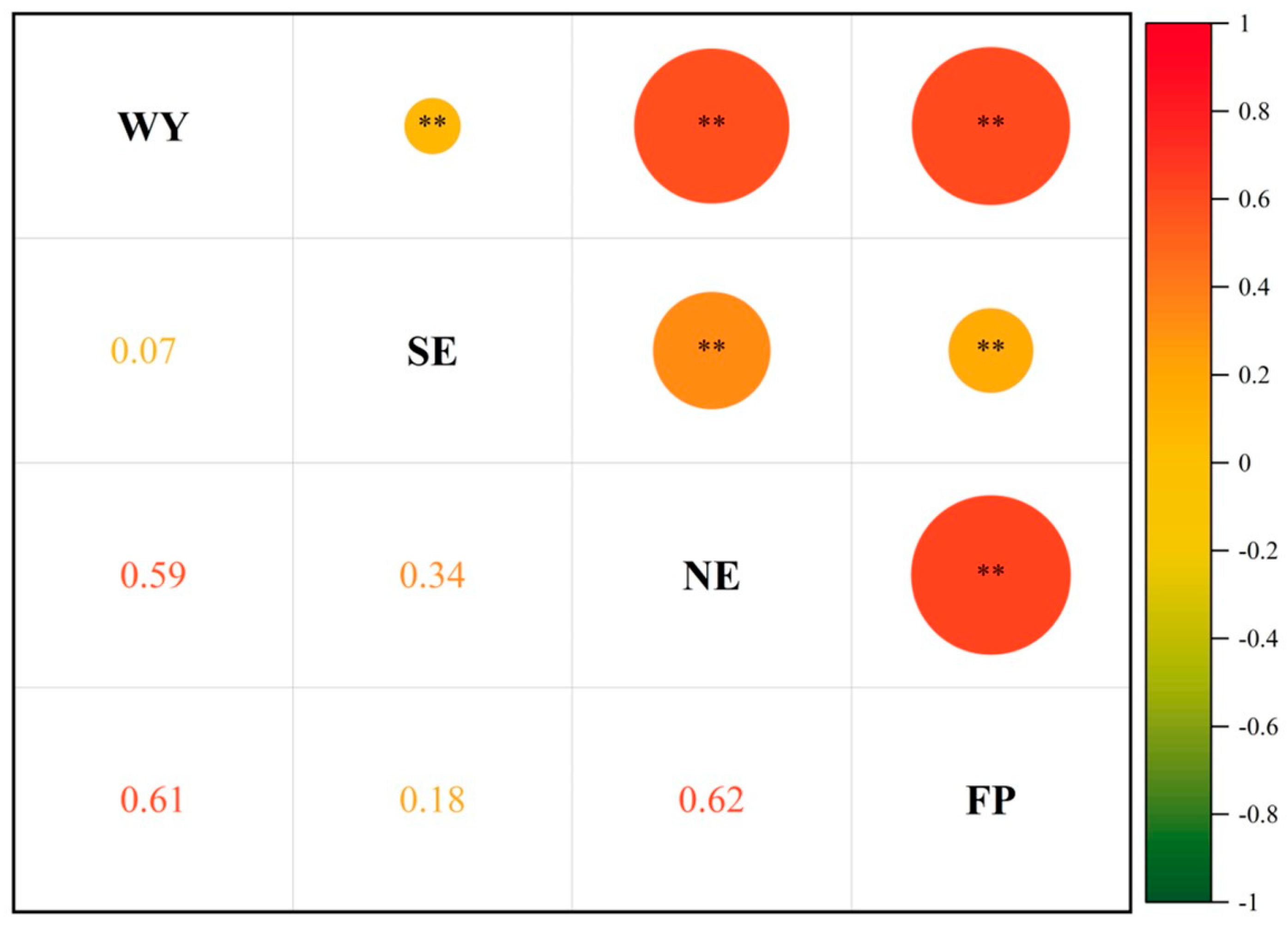
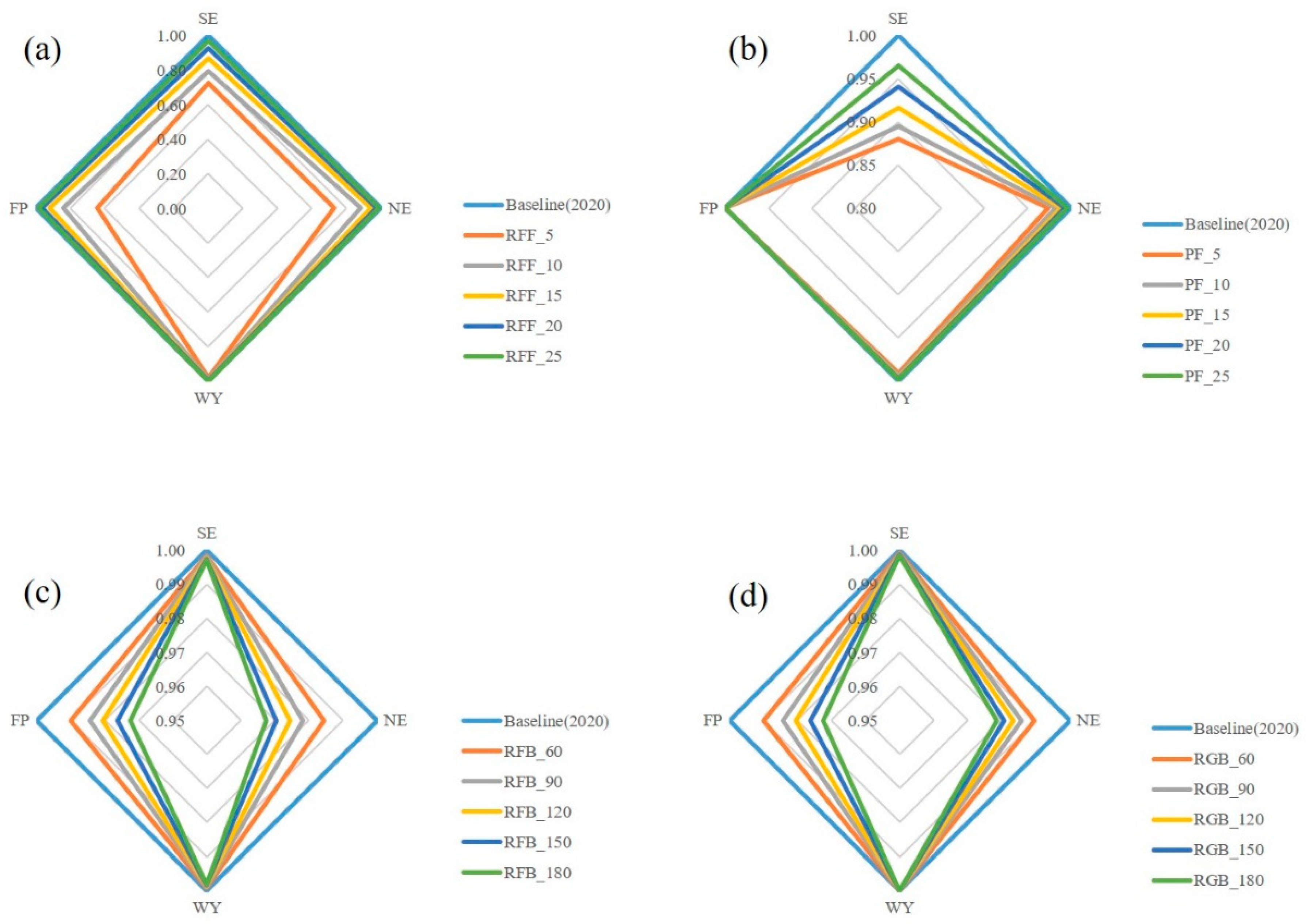

| Data | Type | Resolution | Time | Data Sources |
|---|---|---|---|---|
| Land use data | Raster | 30 m | 2000, 2020 | (http://www.resdc.cn/, accessed on 23 May 2021) |
| NDVI data | Raster | 250 m | 2000, 2020 | (https://ladsweb.modaps.eosdis.nasa.gov, accessed on 23 May 2021) |
| DEM data | Raster | 30 m | 2015 | (http://www.gscloud.cn, accessed on 23 May 2021) |
| Climate data | Raster | 1000 m | 2000–2020 | (http://www.geodata.cn/, accessed on 23 May 2021) |
| Soil data | Raster | 1000 m | 2009 | (http://data.tpdc.ac.cn/zh-hans/, accessed on 23 May 2021) |
| Statistical data | Excel | \ | 2000–2020 | (http://data.cnki.net, accessed on 23 May 2021) |
| Biophysical data | CSV file | \ | \ | Literature [18,42] and the InVEST user’s guide [41] |
| Scenario | Description | Land Use Change (ha) | ||||
|---|---|---|---|---|---|---|
| Farmland | Forestland | Grassland | Unused Land | |||
| Returning Farmland to forest (RFF) | RFF_5 | Farmland with a slope gradient of >5° was converted into forestland | −688,144 | 688,144 | \ | \ |
| RFF_10 | Farmland with a slope gradient of >10° was converted into forestland | −304,374 | 304,374 | \ | \ | |
| RFF_15 | Farmland with a slope gradient of >15° was converted into forestland | −150,710 | 150,710 | \ | \ | |
| RFF_20 | Farmland with a slope gradient of >20° was converted into forestland | −69,540 | 69,540 | \ | \ | |
| RFF_25 | Farmland with a slope gradient of >25° was converted into forestland | −27,593 | 27,593 | \ | \ | |
| Planting forest (PF) | PF_5 | Grassland and unused land with a slope gradient of >5° was converted into forestland | \ | 311,135 | −310,714 | −421 |
| PF_10 | Grassland and unused land with a slope gradient of >10° was converted into forestland | \ | 212,272 | −212,081 | −192 | |
| PF_15 | Grassland and unused land with a slope gradient of >15° was converted into forestland | \ | 141,685 | −141,568 | −117 | |
| PF_20 | Grassland and unused land with a slope gradient of >20° was converted into forestland | \ | 86,744 | −86,677 | −67 | |
| PF_25 | Grassland and unused land with a slope gradient of >25° was converted into forestland | \ | 46,550 | −46,523 | −27 | |
| Riparian forestland buffer (RFB) | RFB_60 | 60 m wide riparian buffer (excluding built-up land) was converted into forestland | −22,999 | 25,548 | −2542 | −6 |
| RFB_90 | 90 m wide riparian buffer (excluding built-up land) was converted into forestland | −35,651 | 39,650 | −3987 | −11 | |
| RFB_120 | 120 m wide riparian buffer (excluding built-up land) was converted into forestland | −44,322 | 49,329 | −4991 | −15 | |
| RFB_150 | 150 m wide riparian buffer (excluding built-up land) was converted into forestland | −53,986 | 60,134 | −6127 | −21 | |
| RFB_180 | 180 m wide riparian buffer (excluding built-up land) was converted into forestland | −62,063 | 69,185 | −7096 | −26 | |
| Riparian grassland buffer (RGB) | RGB_60 | 60 m wide riparian buffer (excluding built-up land and forestland) was converted into grassland | −22,999 | \ | 23,005 | −6 |
| RGB_90 | 90 m wide riparian buffer (excluding built-up land and forestland) was converted into grassland | −35,651 | \ | 35,663 | −11 | |
| RGB_120 | 120 m wide riparian buffer (excluding built-up land and forestland) was converted into grassland | −44,322 | \ | 44,337 | −15 | |
| RGB_150 | 150 m wide riparian buffer (excluding built-up land and forestland) was converted into grassland | −53,986 | \ | 54,007 | −21 | |
| RGB_180 | 180 m wide riparian buffer (excluding built-up land and forestland) was converted into grassland | −62,063 | \ | 62,089 | −26 | |
| Year | 2000 | 2020 | ||
|---|---|---|---|---|
| Land Use | Area (ha) | Percent (%) | Area (ha) | Percent (%) |
| Farmland | 2,035,057 | 25.10 | 1,988,279 | 24.52 |
| Forestland | 5,360,421 | 66.11 | 5,287,054 | 65.21 |
| Grassland | 430,096 | 5.30 | 443,763 | 5.47 |
| Water area | 148,182 | 1.83 | 150,005 | 1.85 |
| Built-up land | 133,076 | 1.64 | 237,801 | 2.93 |
| Unused land | 1059 | 0.01 | 989 | 0.01 |
| Area(ha) | 2020 | ||||||
|---|---|---|---|---|---|---|---|
| Farmland | Forestland | Grassland | Water Area | Built-Up Land | Unused Land | ||
| 2000 | Farmland | 1,860,119 | 90,436 | 9052 | 7761 | 67659 | 30 |
| Forestland | 98,865 | 5,166,929 | 48,013 | 4844 | 41,734 | 35 | |
| Grassland | 12,664 | 24,096 | 385,762 | 1267 | 6301 | 7 | |
| Water area | 6879 | 3791 | 653 | 135,726 | 1134 | 0 | |
| Built-up land | 9713 | 1776 | 276 | 405 | 120,903 | 3 | |
| Unused land | 39 | 26 | 8 | 2 | 71 | 914 | |
| Land Use Conversion | Water Yield (106 m3) | Sediment Export (104 t) | Nitrogen Export (104 kg) | Food Production (104 t) |
|---|---|---|---|---|
| Farmland to forestland | −197.96 | −33.47 | −30.03 | −32.53 |
| Forestland to farmland | 217.05 | 20.67 | 29.22 | 49.51 |
| Farmland to grassland | \ | −0.24 | −2.18 | −3.00 |
| Grassland to farmland | \ | 0.75 | 3.15 | 5.94 |
| Farmland to water area | −68.46 | −0.27 | −2.61 | −2.41 |
| Water area to farmland | 60.48 | 0.19 | 2.51 | 3.00 |
| Farmland to built-up land | 163.65 | −2.81 | −3.70 | −21.72 |
| Built-up land to farmland | −24.01 | 0.36 | 0.97 | 4.41 |
| Forestland to grassland | 106.09 | 13.77 | 3.53 | \ |
| Grassland to forestland | −52.71 | −6.54 | −1.73 | \ |
| Forestland to water area | −32.93 | −0.06 | −0.19 | \ |
| Water area to forestland | 26.07 | 0.07 | 0.18 | \ |
| Forestland to built-up land | 197.87 | −0.93 | 9.40 | \ |
| Grassland to built-up land | 15.53 | −0.37 | 1.11 | \ |
| Scenario | Water Yield | Sediment Export | Nitrogen Export | Food Production | ||||
|---|---|---|---|---|---|---|---|---|
| Value (106 m3) | Percent (%) | Value (104 t) | Percent (%) | Value (104 kg) | Percent (%) | Value (104 t) | Percent (%) | |
| RFF_5 | −1347.83 | −2.06 | −297.00 | −27.72 | −295.60 | −27.10 | −339.25 | −35.73 |
| RFF_10 | −602.41 | −0.92 | −219.22 | −20.46 | −127.32 | −11.67 | −155.24 | −16.35 |
| RFF_15 | −299.14 | −0.46 | −140.85 | −13.15 | −63.96 | −5.86 | −78.31 | −8.25 |
| RFF_20 | −138.08 | −0.21 | −76.28 | −7.12 | −30.39 | −2.79 | −36.58 | −3.85 |
| RFF_25 | −54.77 | −0.08 | −34.08 | −3.18 | −12.43 | −1.14 | −14.66 | −1.54 |
| PF_5 | −612.71 | −0.94 | −128.25 | −11.97 | −28.93 | −2.65 | 0.00 | 0.00 |
| PF_10 | −419.95 | −0.64 | −112.62 | −10.51 | −19.10 | −1.75 | 0.00 | 0.00 |
| PF_15 | −280.61 | −0.43 | −89.93 | −8.39 | −12.70 | −1.16 | 0.00 | 0.00 |
| PF_20 | −171.64 | −0.26 | −63.06 | −5.88 | −7.80 | −0.72 | 0.00 | 0.00 |
| PF_25 | −91.89 | −0.14 | −37.44 | −3.49 | −4.18 | −0.38 | 0.00 | 0.00 |
| RFB_60 | −49.09 | −0.07 | −1.58 | −0.15 | −17.11 | −1.57 | −9.51 | −1.00 |
| RFB_90 | −74.00 | −0.11 | −2.13 | −0.20 | −23.85 | −2.19 | −14.83 | −1.56 |
| RFB_120 | −91.16 | −0.14 | −2.52 | −0.23 | −27.99 | −2.57 | −18.51 | −1.95 |
| RFB_150 | −110.33 | −0.17 | −2.92 | −0.27 | −32.27 | −2.96 | −22.64 | −2.38 |
| RFB_180 | −126.43 | −0.19 | −3.28 | −0.31 | −35.55 | −3.26 | −26.12 | −2.75 |
| RGB_60 | −4.12 | −0.01 | −0.94 | −0.09 | −11.44 | −1.05 | −9.51 | −1.00 |
| RGB_90 | −4.07 | −0.01 | −1.15 | −0.11 | −15.60 | −1.43 | −14.83 | −1.56 |
| RGB_120 | −4.02 | −0.01 | −1.30 | −0.12 | −18.23 | −1.67 | −18.51 | −1.95 |
| RGB_150 | −3.96 | −0.01 | −1.44 | −0.13 | −21.07 | −1.93 | −22.64 | −2.38 |
| RGB_180 | −3.91 | −0.01 | −1.58 | −0.15 | −23.33 | −2.14 | −26.12 | −2.75 |
Disclaimer/Publisher’s Note: The statements, opinions and data contained in all publications are solely those of the individual author(s) and contributor(s) and not of MDPI and/or the editor(s). MDPI and/or the editor(s) disclaim responsibility for any injury to people or property resulting from any ideas, methods, instructions or products referred to in the content. |
© 2024 by the authors. Licensee MDPI, Basel, Switzerland. This article is an open access article distributed under the terms and conditions of the Creative Commons Attribution (CC BY) license (https://creativecommons.org/licenses/by/4.0/).
Share and Cite
Wang, Y.; Zhang, Z.; Chen, X. Impact of Land Use Change on Water-Related Ecosystem Services under Multiple Ecological Restoration Scenarios in the Ganjiang River Basin, China. Forests 2024, 15, 1225. https://doi.org/10.3390/f15071225
Wang Y, Zhang Z, Chen X. Impact of Land Use Change on Water-Related Ecosystem Services under Multiple Ecological Restoration Scenarios in the Ganjiang River Basin, China. Forests. 2024; 15(7):1225. https://doi.org/10.3390/f15071225
Chicago/Turabian StyleWang, Yiming, Zengxin Zhang, and Xi Chen. 2024. "Impact of Land Use Change on Water-Related Ecosystem Services under Multiple Ecological Restoration Scenarios in the Ganjiang River Basin, China" Forests 15, no. 7: 1225. https://doi.org/10.3390/f15071225






